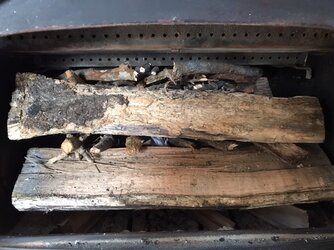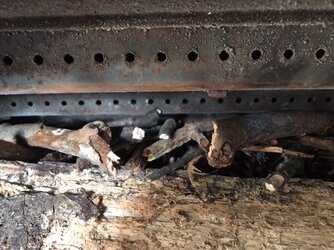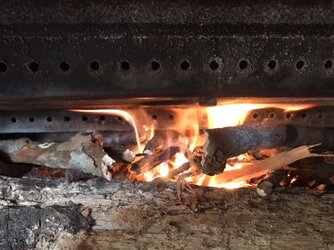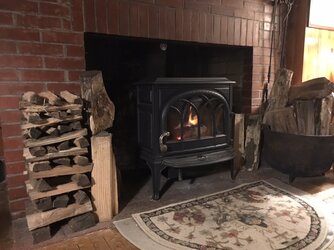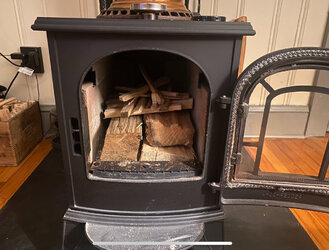So with pushing Top Down set ups about as far as possible, i think i've figured out much of why it works so well in woodstoves,
Especially modern epa stoves with Secondary Combustion.
Today i did probably one of the most Aggressive set ups possible in my jotul f400.
2 East / West rows of Full Size splits that topped out about 2 inches from the baffles.
The bottom splits rest on only 3 sleepers 1" to 2" thick, and the
2nd row sits on 1" thick and smaller sliver and stick sleepers resting on top of the bottom splits.
With barely enough room to get much kindling on top of the 2nd row, the small V gap between the front row and back row held 4 pine cones and small stick kindling.
A very few pieces of small sized sticks were jammed in between the top row and the baffles.
I lit the pine cones in 3 places with an oak sliver.
It caught and burned well with the door closed immediately after lighting.
With such a small amount of starting kindling, i knew i would have to add at least 2 more pieces of stick kindling. Which i did after 1 or 2 minutes.
Closed the door immediately again.
Secondary flames start appearing Very quickly, In just 3 minutes or so and built from there.
Full Secondary flames in 5-6 minutes with flue temp reading 325F in about 6 minutes.
xxxxxxxxxxxxxxxxxxxxxxxxxxxxxxxxxxxxxxxxxxxxxxxxxxxxxxxxxxxxxxxxxxxxxxxxxxxxxxxxxxxxxxxxxxx
So why does it work so well?
The biggest reason i think is you've created a Flexible size fire box.
The small top fire is essentially starting in up to an 80-90% smaller firebox. With the splits underneath taking up the majority of the space below and a "platform" to start on, you are practically "Raising" the floor of your box. The more you raise it with splits the smaller the "Starting" size of your box.
This "Smaller" box is now also Much closer to the baffle and secondary tubes. The starter flames immediately touch the tubes heating them, and the baffle, instantly. As the starter fire is small with limited fuel the smoke it can produce is very limited. Since the flames do not have to run thru larger splits (as it does with a bottom up) the flames are not cooled on a long path to the baffle. And the warming of those splits are not producing extra smoke from the weak limited heat.
As the Top down burns down, the firebox size grows as the splits below start to burn. The smoke from those splits now travels up thru the starter fire flames and into the already fully burning secondary tubes where it gets the chance to be reburned. As the fire progresses, the top air gap increases allowing more air velocity under the baffle and thru the splits below. The increased air flow, as the firebox size "grows", pumps the vigorous burning to higher levels.
This process continues as the fire works it's way down to the base of the firebox.
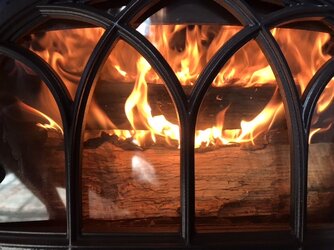
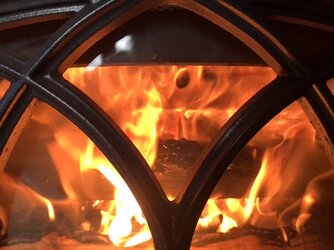
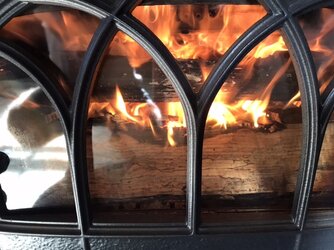
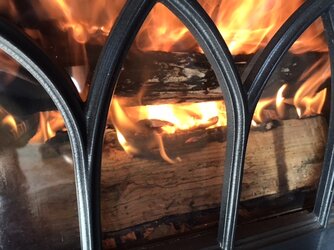
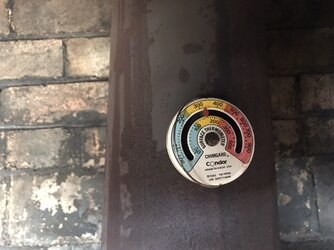
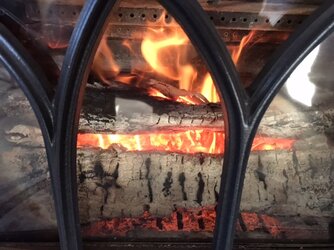
Especially modern epa stoves with Secondary Combustion.
Today i did probably one of the most Aggressive set ups possible in my jotul f400.
2 East / West rows of Full Size splits that topped out about 2 inches from the baffles.
The bottom splits rest on only 3 sleepers 1" to 2" thick, and the
2nd row sits on 1" thick and smaller sliver and stick sleepers resting on top of the bottom splits.
With barely enough room to get much kindling on top of the 2nd row, the small V gap between the front row and back row held 4 pine cones and small stick kindling.
A very few pieces of small sized sticks were jammed in between the top row and the baffles.
I lit the pine cones in 3 places with an oak sliver.
It caught and burned well with the door closed immediately after lighting.
With such a small amount of starting kindling, i knew i would have to add at least 2 more pieces of stick kindling. Which i did after 1 or 2 minutes.
Closed the door immediately again.
Secondary flames start appearing Very quickly, In just 3 minutes or so and built from there.
Full Secondary flames in 5-6 minutes with flue temp reading 325F in about 6 minutes.
xxxxxxxxxxxxxxxxxxxxxxxxxxxxxxxxxxxxxxxxxxxxxxxxxxxxxxxxxxxxxxxxxxxxxxxxxxxxxxxxxxxxxxxxxxx
So why does it work so well?
The biggest reason i think is you've created a Flexible size fire box.
The small top fire is essentially starting in up to an 80-90% smaller firebox. With the splits underneath taking up the majority of the space below and a "platform" to start on, you are practically "Raising" the floor of your box. The more you raise it with splits the smaller the "Starting" size of your box.
This "Smaller" box is now also Much closer to the baffle and secondary tubes. The starter flames immediately touch the tubes heating them, and the baffle, instantly. As the starter fire is small with limited fuel the smoke it can produce is very limited. Since the flames do not have to run thru larger splits (as it does with a bottom up) the flames are not cooled on a long path to the baffle. And the warming of those splits are not producing extra smoke from the weak limited heat.
As the Top down burns down, the firebox size grows as the splits below start to burn. The smoke from those splits now travels up thru the starter fire flames and into the already fully burning secondary tubes where it gets the chance to be reburned. As the fire progresses, the top air gap increases allowing more air velocity under the baffle and thru the splits below. The increased air flow, as the firebox size "grows", pumps the vigorous burning to higher levels.
This process continues as the fire works it's way down to the base of the firebox.








